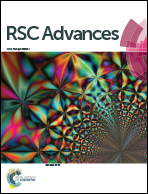Effects of active compounds from Cassia fistula on quorum sensing mediated virulence and biofilm formation in Pseudomonas aeruginosa†
Abstract
Pseudomonas aeruginosa infections are attributed to its ability to form biofilms and are difficult to eliminate with antibiotic treatment. Biofilm formation is regulated by quorum sensing (QS), an intracellular bacterial communication mechanism that allows the activation of numerous virulence factors and secondary metabolites. Targeting the QS pathway is a potential approach that prevents QS-controlled phenotypes and biofilm formation. For the first time, the current work has identified antiquorum sensing activity in the partially purified four fractions from the hot ethyl acetate extract of Cassia fistula fruit pods. Of the four fractions, only fraction-1 gave decreased AHL activity; the phytoconstituents in this fraction were identified as rhein, 3-aminodibenzofuran, 5-(hydroxymethyl)-2-(dimethoxymethyl)furan, and dihydrorhodamine. Fraction-1 (1 mg ml−1) and rhein (0.15 mg ml−1) showed 63% and 42.7% reduction in short-chain AHL production, respectively, without hindering the bacterial growth. Fraction-1 inhibited QS-mediated extracellular virulence factors viz. protease, elastase, pyocyanin, and rhamnolipid (p < 0.05). Quantitative analysis of biofilm formation showed 77% & 62.4% reduction by fraction-1 (1 mg ml−1) and rhein (0.15 mg ml−1) respectively. Confocal laser microscopy (CLMS) & scanning electron microscopy (SEM) confirmed the reduction of biofilm formation in Pseudomonas aeruginosa upon treatment with fraction-1 and rhein. Moreover, the in vivo study displayed that fraction-1 and rhein (standard) significantly enhanced the survival of Caenorhabditis elegans by suppressing the potency of virulence factors of Pseudomonas aeruginosa. Quantitative real-time polymerase chain reaction results demonstrated the down-regulation of QS-related genes, lasI, lasR, rhlI, and rhlR. In addition, in silico analysis divulged that a component identified by GC-MS displayed a strong affinity towards LasI and LasR. These findings suggest that potent phytochemicals from fraction-1, including rhein, could serve as novel phytotherapeutics in controlling emerging infections of antibiotic-resistant bacterial pathogens like Pseudomonas aeruginosa.



 Please wait while we load your content...
Please wait while we load your content...